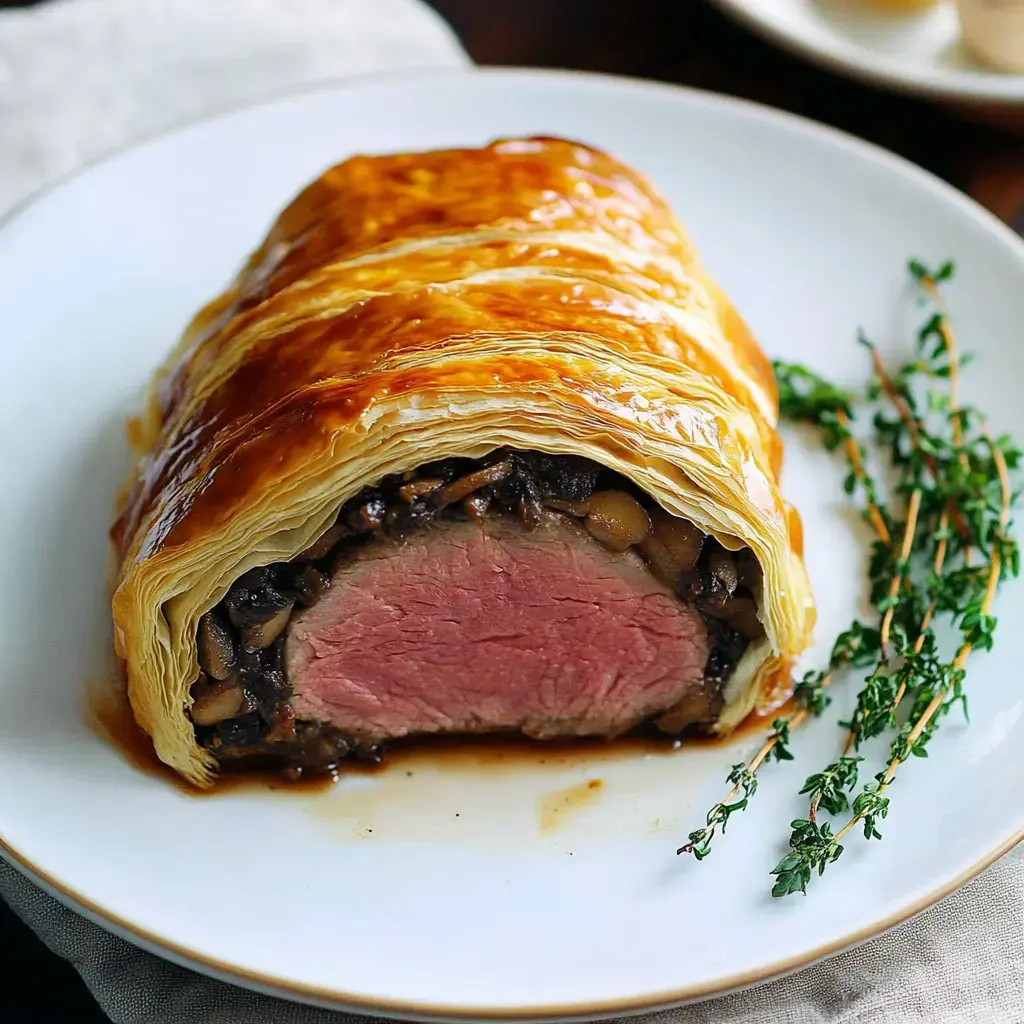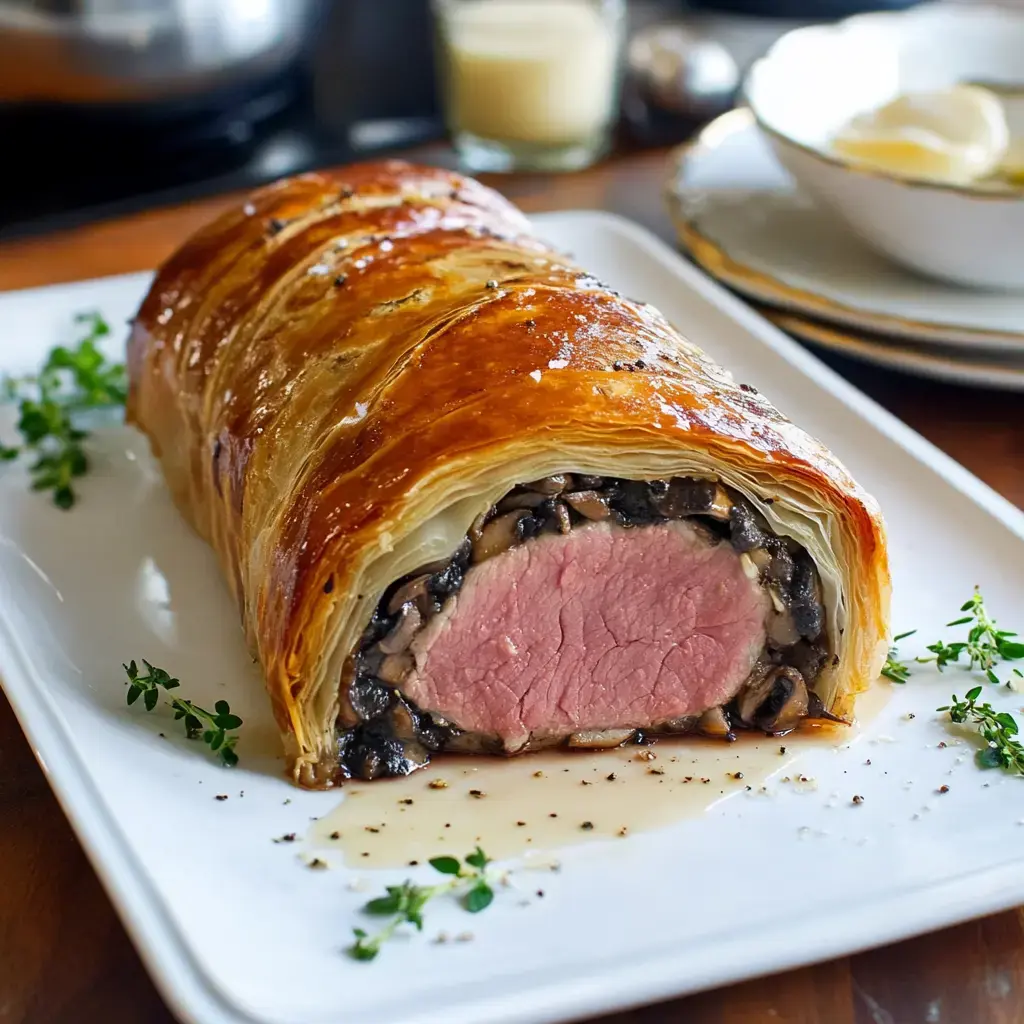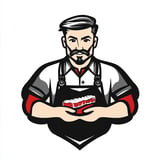 Pin it
Pin it
Ever wonder about beef wellington? It's a fancy meal where juicy beef gets tucked inside mushrooms, ham, and crispy pastry. This take draws inspiration from Gordon Ramsay's well-known method, making it doable yet still wow-worthy.
An Elegant Mealtime Favorite
Going all the way back to the 1800s, beef wellingtons have shown up on fancy dinner tables for centuries. It's just right for special occasions, turning good beef into something extraordinary. Though it looks complicated, store-bought pastry makes this way easier than you might guess.
What You'll Need
- Beef Tenderloin: Picking the right cut matters - go for top-quality tenderloin
- Salt and Pepper: Basic seasoning does the trick
- Olive Oil: Needed for browning
- Mustard: Gives a nice zip
- Mushrooms: Builds deep flavor
- Ham or Prosciutto: Brings salty goodness
- Puff Pastry: Creates that beautiful crust
- Egg Yolks: Makes it glossy
- Flaky Salt: The finishing pop
Cooking Instructions
- Warm Oven:
- First get your oven hot at 400°F. The right temperature makes sure your Wellington browns evenly with that gorgeous golden outside.
- Season:
- Cover your beef tenderloin completely with salt and fresh black pepper. Don't hold back - proper seasoning means tastier results.
- Sear:
- Get a sturdy pan super hot. Brown your beef on every side until dark and crusty, roughly 2-3 minutes per side. This keeps all those yummy juices inside.
- Add Mustard:
- After the meat cools a bit, paint it with mustard everywhere. This adds flavor and works like glue for the other ingredients.
- Prep Mushrooms:
- Throw your mushrooms in a food processor and pulse until they're finely chopped but not turned to mush. You want tiny pieces that still have some texture.
- Cook Mushrooms:
- Put your chopped mushrooms in a dry pan and cook until they're completely dry, about 10-15 minutes. Mix often - this step stops your pastry from getting soggy later.
- Layer:
- Spread out your ham pieces, cover with the mushroom mix, then put your mustard-coated beef in the middle. Each part adds taste and helps keep the crust nice and crisp.
- Wrap:
- With plastic wrap, roll it all up tight and tuck in the ends. Let it cool in the fridge for 30 minutes to get firm - this makes the next part so much easier.
- Add Pastry:
- Gently wrap your cold beef package in puff pastry, making sure all edges are closed well. Take it slow - good wrapping prevents leaks during baking.
- Finish:
- Brush beaten egg all over the pastry for that pretty shine, then cut diagonal marks on top. These little cuts let steam out and create that classic look.
- Bake:
- Put it in your hot oven and cook until the pastry turns a rich golden brown and gets crispy, about 40-45 minutes if you want medium-rare.
- Rest:
- Let your Wellington sit for 10-15 minutes before cutting. This keeps the juices inside the meat when you slice it, giving you beautiful, pink pieces.
Storied Background
Tiny beef wellington appetizers got big in the 1960s, but the original goes back way further. Named after the Duke of Wellington, this dish blends French cooking skills with British traditions, making something truly outstanding.
Simplifying The Process
When you scan through beef wellington directions, it can look tough, but tackling it step by step makes it totally doable. Just focus on one layer at a time. Even first-timers can nail this dish by just following along carefully.
Prep Work Tips
Thinking about beef wellington bites for your get-together? Fix the mushrooms and beef the day before. This cuts down your work when it's cooking time, whether you're going for the full-size version or tiny ones for snacking.
Finding The Best Meat
To figure out what beef for wellington works best, check with your meat seller. They'll point you to the ideal tenderloin piece, so your meal turns out juicy and full of flavor. Good meat really is the foundation of this classic dish.
 Pin it
Pin it
Tasty Accompaniments
While your beef wellington cooks, whip up easy sides like roasted potatoes or green beans. These traditional partners let your main dish be the star but round out your special dinner. Don't forget, the right sides can take great meals up another notch.
Frequently Asked Questions
- → How do I know the meat’s done?
Use a meat thermometer. You’re aiming for around 52-54°C for a juicy, medium-rare center. Let it rest a bit after cooking so the juices settle. Stay mindful—it’ll keep cooking slightly as it rests.
- → Can I get it ready in advance?
You can prepare everything up to the point right before adding the pastry. Keep it tightly wrapped and chilled. Bake just before you want to serve, letting the beef come close to room temperature first. Makes it fresher!
- → What if the pastry feels too soft?
Pop it in the fridge for a while until it firms up. Working with cold pastry ensures those layered textures stay intact. Patience here is key!
- → Can I make the mushroom mixture ahead?
Sure, make it up to two days in advance. Store in the fridge in a sealed container. Just make sure to finely chop them and cook out all the liquid for the best results.
- → Which wine pairs best with this meal?
A bold, full-bodied red works great. Think of a French Bordeaux or a Burgundy-like Pinot Noir. You want something that’s rich enough to complement the beef but not overpower it.
- → What should I do if it’s browning too much?
Lay a sheet of foil loosely over the top and lower the oven temperature slightly. You can also shift the pan to a lower rack. Keep a close eye to avoid overbaking.
- → Can I take it to a party?
It’s tricky to move freshly baked, as it’s best right out of the oven. Consider baking it on-site if possible! Have everything prepped and your destination’s oven preheated for smooth timing.
- → How can I speed things up?
Prep all the components beforehand, and let your beef come to room temperature before searing. Doing these steps ahead of time can save you frustration, but don’t skip essential steps like resting or chilling the pastry.
- → How do I adjust for a larger portion?
Bigger portions will call for longer cooking times. Use a thermometer to keep an eye on the internal temperature. Add foil if necessary to avoid overbrowning the pastry while waiting for the center to cook.
- → How do I boost flavor?
Layer in stronger herbs or a touch of Dijon mustard when assembling. You can even brush the beef with red wine reductions. Just make sure it enhances and doesn’t mask the natural flavors of the beef!
- → What if my pastry doesn’t puff nicely?
Make sure all the components stay chilled. Lightly score the top with a knife and go easy on the egg wash. A hot oven kickstarts the puffing, and a little steam makes that flaky magic happen!
- → I overcooked the beef—what now?
Pull it from the oven earlier next time and allow for a longer rest after baking. Also, rely on your thermometer! It’s always better to end up a tad undercooked, as you can’t undo an overcooked center.
Conclusion
If you enjoy this, consider trying a hearty meat pie or succulent glazed pork baked in a similar crust. Perfect for showing off your culinary skills!
